Marxist historians in China, being in search for the age of slaveholder society (nuli shehui 奴隸社會) as supposed by the theories of historial materialism, found this society (see Shang society) in the Shang period 商 (17th-11th cent. BCE). Slaves did indeed constitute an integral part of the Shang economy, but the question of ownership is less than clear. While in ancient Rome, slaves were usually privately owned, they were part of a social hierarchy in which lower classes contributed economically to the higher classes, i.e. the royal house and the princely lineages. It is interesting to see that the term "slave" (nu 奴) does not occur in oracle texts (Keightley 1999: 285-286).
The most important part of traditional China's economy was the agricultural sector. The kings of Yin as shamans and diviners did not only carry out divinations about the harvest of their own domain, but also about that of the greater area that was politically controlled by Shang. The most important crop of this period was millet in various kinds (shu 黍, su 粟, he 禾). Opening up new fields and organising the harvest and tax collection was the task of various government officers. Labour conscripts (zhongren 眾人, "the multitudes") stood in the service of the kings and were employed for different task like field opening, military service, buildings palaces and temples or digging out tombs for deceased nobles.
Apart from fiels, the kings of Shang also owned and managed royal herds. A specialized but also ritualized activity of the nobility was hunting (tian 畋) in autumn. From oracle bone incriptions we know that the harvest was stored in royal granaries. Archaeology has delivered examples of ploughs and other agricultural tools with wooden shafts and bronze or stone blades. Silk production was also well-developed during the Shang period.
The royal workshops were staffed with labourers that cast bronze vessels or other bronze tools like musical instruments (drums gu 鼓, many kinds of bells: nao 鐃, zheng 鉦, ling 鈴) and weapons (dagger ge 戈, spear mao 矛, including ritual tools like axes yue 鉞), carved ritual jades and prepared tortoise shells for divination.
Surprisingly enough, the labour conscripts did not engage in waterwork. The digging or irrigation canals or the erection of dams seemed not to be within the crucial tasks of the kings of Yin, like it became later one of the most important charges of the Chinese rulers.
Chinese scholars assume that the king of the Shang dynasty disposed of large tracts of land that were worked by serfs or slaves. The king had the right to confer the rights over land and work force to members of the royal lineage or families closely interrelated to the state (feng yi 封邑), but could also take away these rights (Zhou 2000: 189-190).
Fields were quite probably divided into segments of equal size, as can be seen in the characters used for the word field (tian 田, jing 井). Some scholars therefore hold that the Shang made use of the so-called well-field system (jingtianzhi 井田制) better known as an agricultural system of the Western Zhou dynasty 西周 (11th cent.-770 BCE) (Ma 1994: 145; Zhou 2000: 201).
The royal seat was the core of a "centripetal economy" in which tributes were delivered from all regions to the economic centre in the royal capital, while the king in turn bestowed rewards, land, and people on his subordinates and allies (Chang 1980: 158; Campbell 2018: 105, 111).
The political survival of a dynasty was always dependent from the harvest. For this reason, the Shang kings invested their energies in the survey of agricultural activities, but also in the support of it by deities, to which regular offerings were delivered. Oracles requested information about the eventual outcome of harvest. The Zhou dynasty later blamed the Shang for having neglected the administration of agricultural activities, and in particular, having focussed too much on the production of wines.
The observation of the sky and the weather was important for the arrangement of agricultural activities. The four seasons and their phenomena were part of a cosmology, in which cardinal directions and the winds prevailing were fundamentally tied to the four seasons. The Shang-period word for "year" was nian 秊 "harvest" (the image of a person carrying the full ears, modern character 年) in the context of agriculture, and si 祀 in the context of the annual rhythm of royal sacrifices. The Shang kings prayed for a good harvest, for rain, received reports of a good harvest, and offered part of the harvest to the ancestral spirits (deng chang 登嘗).
Archaeology brought to light countless agricultural tools made of stone or bronze. Even in the tombs of the higher class, howes, adzes, whetstones (li 礪), sickles (dao 刀, lian 鐮 or zhi 銍), or spades (chan 鏟) were found, which shows that the royal house and the princely lineages were directly involved in agricultural activities, if not physically, then in their duty to direct the farmers. The produce was stored in various types of earthenware jars, guan 罐, weng 瓮, large-mouth zun 尊. The large number of cooking vessels li, ding, zeng was used to prepare grains, for instance, to congee the word yu 鬻 (鬲plus 粥) means to cook.
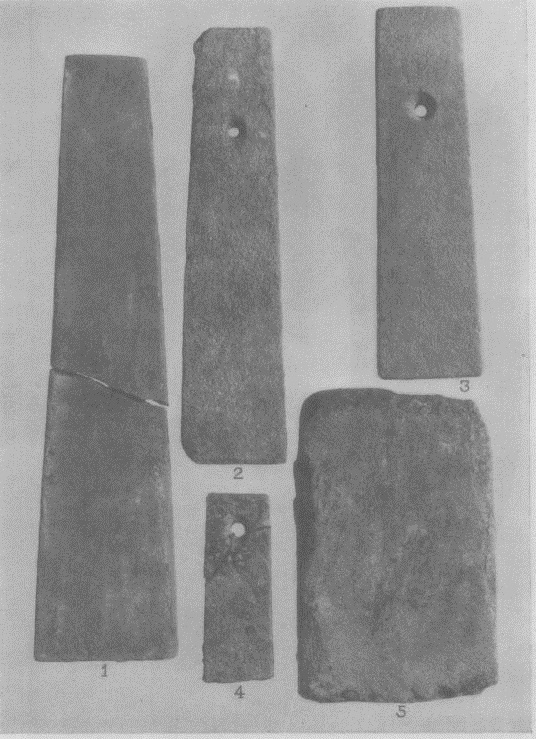 |
|
Whetstones (li 礪) from a Shang tomb. From Ma, Zhou, Zhang 1955: Plate 22. |
|
The staple grain of the Shang period was foxtail millet (su 粟, briefly called he 禾, Setaria italica). The word he (the image of ripe ears) therefore also meant, in a wider sense, all other grains. Less often cultivated, but much more precious, and therefore part of many sacrifices, was glutinous millet (shu 秫 or ji 稷, also written 𣲲, today called niansu 黏粟). Of broomcorn millet (shu 黍, Panicum miliaceum), two kinds were known, namely glutinous and non-glutinous (mei 𪎭 or ji 穄). The words lai 來 or 䅘 designated perhaps wheat. The character 䅘 (or 禾 above 來) was created to discern the word for the plant or the grain from the character borrowed for the word "to come" (actually "to bring grain [to the court]"). The word mai 麥 was used for barley (Bray 1984: 440).
Beans (ji 菽) counted amount the "five grains" (wugu 五穀) in traditional language. The oracle character showed grain 米 above a vessel (like {米/缶}), while the modern character for "beans", dou 豆, is the image of a special type of vessel. Dry rice (ni 秜, modern word dao 稻) is only mentioned once in oracle inscriptions (Zhou 2000: 231). A character with some lines above a field is interpreted as the Shang-period form of sorghum (Sorghum bicolor, gaoliang 高粱).
The Shang discerned between lowland (shitian 濕田 "wet land") and land located on heights (shangtian 上田, qiangtian 墻田), and divided lands into four classes (si pin 四品) attributed after inspection (xing tian 省田) by officers or by the king. It can be seen from oracle inscriptions that the use to grade fields according to quality was already known during the Shang period. The term tu tian 土田 (and perhaps also the word {沚/土} = du 度) meant to measure fields and to carry out a kind of cadastral survey (Zhou 2000: 246). Land selected for cultivation was cleared by cutting trees and shrubs (zuo 柞) and rooting out herbaceous plants (ru 蓐). In intervals of 18 months, land was reclaimed and cultivated (pou 裒, later called ken 墾).
The soil was prepared by ploughing. The plough (original character 力) was drawn by a team of two persons. Inscriptions use two words for the plough, namely one with a spade-shaped share (xie or li {劦/口}, later called si 耜), and one with a slightly forked, "bidentate" plough share (ji 耤). It is quite probable that the Shang already used oxen to draw ploughs, {ㄉ+牛} (later term li 犁 or 犂), at least on land cultivated for a long time already, as can be concluded from the discovery of V-shaped ploughshares (Zhou 2000: 256-257; Bray 1984: 141-142). Fields were managed by creating canals for irrigation and dewatering, and also by heaping up ridges (龍, i.e. long 壟, also called 尊, i.e. cun 壿) to prevent erosion.
The climate of the Shang period was warmer and wetter than today, so agricultural yields must have been easier to obtain, and de-watering was more important than it is nowadays (Marks 2012: 21, 40-53).
The mowing of grass (shan 芟, later usually called yi 刈) or the cutting of weeds (xun {兮/旬}) with the help of hoes (chu 鉏, 鋤) belonged to the regular work on the fields through the year. The construction of irrigation facilities is proved by water tubes found in several cities of the Shang. Canals and dams belonged to regular agricultural work since the Longshan period 龍山 (3200–1850 BCE), and is attested in quite a few mythological accounts. The expression zheng he 正河 meant "to regulate rivers", perhaps by constructing dams. Wells (jing 汫, later term 井) were also mentioned in inscriptions.
Crickets and locusts (called qiu 秋, perhaps in imitation of noise they made) were "silenced" (ning 寧) by burning the land where these pests were living. In some cases, birds also belonged to animals endangering the harvest, and were driven away.
The word {尸+少} perhaps signified dung distributed on the fields in the winter months. There is no word for sowing in oracle inscriptions. Instead, the names of the particular plants were used as verbs: "to grow millet".
The Shang king either sent out his officials to supervise agricultural work on the royal domain, or personally inspected or attended (li 立=莅) the work. The harvest was supervised by the lesser mowing officials (xiaoyichen 小刈臣), ploughing by the lesser ploughing officials (xiaojichen 小耤臣). Alternatively, the king "appealed" (hu 呼) to other dignitaries with such duties, for instance, a prince or a consort. The results of the harvest were reported to the royal court.
There were two methods of harvesting grain, namely cutting the plant with the stalk, or cutting just the ear, and leaving the stalks on the field as manure. The ears were not immediately threshed, but the grains were left inside the chaff and only threshed out when needed. Grain was either stored in jars in subterranean pits, or in granaries (lin 㐭, later written 廩). Both were guarded against theft and raiding enemies.
One might say that animal husbandry was an integral part of the Shang economy even before the foundation of the dynasty by Tang the Perfect 成湯. Xiang 相, a grand-son of Xie 契, is said to have mastered riding (according to Shiben 世本), and Wang Hai 王胲(=亥) is said to have raised and traded with cattle 駕牛 (Shiben, Yijing 易經, Chuci 楚辭, ch. Tianwen 天問, Shanhaijing 山海經). The book Guanzi 管子 (ch. Qingzhong 輕重) says that the people of Yin (Shang) had stables and throughs to rear cattle and horses. Archaelogists found bones of all domestic animals in Shang sites. The oracle vocabulary concerning the rearing and breeding of domestic animals is rich, and shows that animals husbandry was a well-developed business.
Domestic animals, cattle, sheep, pigs, and also dogs, were used as sacrificial animals (xisheng 犧牲) in high numbers up to 600 in one single offering (Zhou 2000: 282-283). The Shang knew large lots (dalao 大牢) and small lots (xiaolao 小牢) of sacrificial animals. The word lao 牢 was actually a cowshed or sheep pen. Jiu 厩 were horse stables, and huan 圂 pigsties.
Apart from common domestic animals (mammals, birds, and fish), the Shang also kept deer and elephants. Elephants are mentioned in inscriptions, and parts of a skeleton were found in tomb M1400 in Anyang 安陽, Henan, in 1935, and in 1978 in Wuguancun 武官村 (Zhou 2000: 294). Ivory was a widely used material. The old name of the province of Henan was Yu 豫 (radical elephant 象 plus phonetic yu 予). This shows that in earlier ages, elephants were indeed found in the Yellow River plain (Elvin 2004: map 2).
The glossary Erya 爾雅 defines concentric regions of economic activity around settlements: settlements (yi 邑), suburbs (jiao 郊), pastures (mu 牧), uncultivated land (ye 野), forests (lin 林), and wilderness (jiong 埛). The word muye 牧野 outside of the last Shang capital was even the place – located in the outskirts of the royal pastures - where the last ruler of the Shang, King Zhou 紂, was defeated by the Zhou. The Shang kings, and the members of the princely lineages and regional rulers as well, had quite a few pastures were different kinds of domestic animals were raised. Oracle inscriptions mentioned the northern and southern pasture(s) of Anyang, beimu 北牧, and nanmu 南牧, as well as a few place names.
The overseer of a pasture (mu) was called mu, and the words niu 牛 "cow" or chu 芻 "hay" could be used as verbs: "to pasture cows", "to feed animals". The overseer or chief overseer (yamu 亞牧) was supported by a few specialized functionaries, which in turn commanded herdsmen, which often belonged to the class of Qiang 羌, i.e. serfs or slaves. There were "chief feeders" (chuzheng 芻正), officers for horses (maya 馬亞, duomaya 多馬亞, duoma 多馬, maxiaochen 馬小臣), officers for cattle (niuzheng 牛正, niuchen 牛臣), for pigs (sishi 司豕, zhisi 彘司, sijia 司豭), or such for dogs (which were also made to meat) or hounds (siquan 司犬).
The administration of pastures was so important that overseers regularly reported to the king and were rewarded (shang 商=賞) in case of good results. The king then and when inspected royal pastures.
Arrowheads of bronze, stone, bone, or shell, were discovered in many places. These were certainly not only used for war, but also for hunting. There were many words for hunting in oracle inscriptions, and these occur so often that it can be concluded that hunting or sporting was a very important activity of the Shang king or the nobility. The latter were allowed to hunt for themselves, or together with the royal court. Hunting is particulary important in inscriptions of the reign of King Kang Ding 康丁 (trad. r. 1219-1199) and during the very late Shang period.
The usual words for hunting were tian 田 (as a verb, later usually written 畋), shou 狩 (actually the same as shou 獸, as a verb, "to hunt [wild animals] with hounds"), xian 陷 or jing 阱 "to trap", wang 網 "to catch with nets", she 射 and tan 彈 "to shoot", bu 捕 "to catch", cong 從, zheng 征, zhu 逐 "to trail, to pursue, to chase", fen 焚 (hunting after having burnt down thickets, or with torches), and many other expressions for which no modern characters exist, for instance, the combination of a net with rabbits or hares, or a net and a tiger.
The Shang hunted tigers, elephants (up to ten in one shoot), wild buffaloes (xi 兕), the boar (shi 豕), deer (lu 鹿), elaphure (mi 麋, up to 450), fawns (ni 麑), foxes (hu 狐), rabbits, and various species of birds.
Before hunting, the royal court had realized a divination about the best point of time during a ten-day week. The usual period for hunting was winter. The king might convoke the nobles to participate in a hunt. Such an event was thus at the same time physical training, social entertainment, the cementation of social relations, and the regulation of political power. The dogs were led by specialized dog handlers (the word quan 犬 meant both the animal and its handler). Among the footmen accompanying the hunting party were many Qiang serfs.
Fish is often mentioned in oracle inscriptions, and bones were found in Shang-period sites. Fish was, apart from meat, used as offer to the deities.
Royal fishing activities yielded as much as 30,000 animals, including mullet (Mugil cephalus, ziyu 鯔魚), yellowhead catfish (Tachysurus fulvidraco, huangsangyu 黃顙魚), carp (liyu 鯉魚), black carp (Mylopharyngodon piceus, qingyu 青魚), grass carp (Ctenopharyngodon idella, caoyu 草魚), barbel chub (Squaliobarbus curriculus, chiyanzun 赤眼鱒), and even sturgeons (xun 鱘) (Zhou 2000: 322).
Fishnet weights of stone or clay and fishing-hooks of bronze, bone, and shell were found in excavations, and both fishing methods are mentioned in inscriptions. Fishing with spears must also have been common. The word shou 受 "to obtain" is an image of two hands left and right of a boat and might have had the meaning of "fishing". Fishing with the help of creels (quan 筌) or other fish traps as well as cormorant (luci 鸕鷀) fishing was known from the early Neolithic on. The jade objects found in the tomb of Queen Fu Hao 婦好 include jade and stone figurines of cormorants.
Like hunting, fishing was an activity bound to certain seasons, mostly winter. Before beginning large fishing activites, the royal court used to bring sacrifices to the "supervisor of fish" (siyu 司魚), a deity believed to nourish that class of animals. Oracle bone inscriptions also mention fish ponds.
The most outstanding form of handicraft of the Bronze Age are of course the ritual bronze vessels which found their origin as imitations in metal of pottery vessels. The use of bronze vessels spread very quickly and is attested in all contemporary sites dated 1500-1000 BCE.
Apart from ritual bronze vessels (qingtong liqi 青銅禮器), weapons (sword, daggers, spearheads, arrowheads, ge 戈-type dagger-axes, axes of the types yue 鉞 and fu 斧, implements of bows), decorations (mainly for chariots and horse-gear, but also for buildings), musical instruments (bells and drums) and tools (hoes, spades, mattocks, hammers, adzes, chisels) were made of bronze.
The oldest bronze vessels imitate traditional shapes of pottery vessels, like li 鬲-type tripods with pointed legs, jue 爵 and jia 斝 beakers with three feet, he 盉 cans, ding 鼎-type tripods, square ding, you 卣 cans, lei 罍 jars, gu 觚 cups, zun 尊 vases, pou 瓿, gui 簋/𣪕, yu 盂, and dou 豆 bowls, or pan 盤 basins.
As skills increased, the types of decorations became more sophisticated, the modes of combining bodies with legs, handles, or other protruding parts, and the shapes of vessels became more inventive.
Outside of the cultural sphere of the Shang, local styles prevailed and resulted in the creation of more anthropomorphical objects, like the famous mask of Xingan 新淦 (新干), Jiangxi, or the masks, heads, and statues of Sanxingdui 三星堆, Sichuan.
The alloy of Shang bronze vessels consists of copper (Cu) and tin (Sn), yielding bronze, Cu and lead (Pb), constituting brass, and of a triple composition of Cu, Sn, and Pb. The melting point of an alloy with 15 per cent of Sn is 960°, with 40 per cent of Sn only 810°. Addition of Pb has not these positive results for melting, but allows for better decorations.
The early Zhou-period text Kaogongji 考工記, transmitted as part of the ritual classic Zhouli 周禮, explains that an alloy with a proportion of 6 Cu (jin 金, pure copper): 1 Sn (14.3%) was good for bells and tripods (zhong ding), a relation of 5 Cu: 1 Sn (16.7%) good for axes (fu, jin 斤), a relation of 4 Cu: 1 Sn (20%) good for dagger-axes and halberds (ge, ji 戟), a relation of 3 Cu: 1 Sn (25%) good for swords (daren 大刃), a relation of 5 Cu: 2 Sn (28.6%) good for deadly arrowheads, and a relation of half Cu, half Sn good for mirrors (jiansui 鑒燧, explained as "light and dew collectors") (Zhou 2000: 376-377).
Yet in practice, the alloy of Erligang-period 二里岡文化 (1600-1400 BCE) vessels (as far as analyzed) was quite instable and often included Sn as well as Pb. Even in one single tomb as that of Queen Fu Hao, the alloy of vessels differed considerably, but the finding of a high Sn content in case of ge-type weapons is attested. The casters knew well that the addition of Pb would make weapons weak and brittle (Zhou 2000: 378-380). In smaller tombs found in Anyang, 44 per cent of all metal objects were made of brass, 21 of bronze, 26 of a triple alloy Cu-Sn-Pb, and 9 per cent of nearly pure copper. Tin seems to have been expensive and was therefore less often used by commoners (Zhou 2000: 382). Such analyses show that Shang period casters knew quite well to adjust the mixture of different metals to an alloy.
The need for copper and other metals can be qualified by the fact that in the tomb of Queen Fu Hao, bronze and brass objects with a weight of 1,625kg were found, and in the tomb of Queen Mu Wu 母戊, a square ding vessel with a weight of 875kg was discovered (Zhou 2000: 389). Ores detected in the remains of foundries in Shang sites allow to trace the origin of the metal. Copper ore was abundant in ancient China, as is stated in many sources like Guanzi (ch. Dishu 地數), Shanhaijing or Shiji 史記 (129 Huozhi liezhuan 貨殖列傳). A reconstruction on the base of literary sources yields no less than 161 copper deposits in ancient China (Zhou 2000: 390).
Shang-period copper mines were located in Dongxiafeng 東下馮, Shanxi, Donglongshan 東龍山, Shaanxi, Tongling 銅岭 near Ruichang 瑞昌, Jiangxi, Tongling, Anhui, Tonglüshan 銅綠山 close to Daye 大冶, Hubei, and quite a few places in Anhui, Jiangxi and Hunan (Liu and Chen 2003: 76), and a few elsewhere, like Dajing 大井 close to Linxi 林西, Liaoning. Close to the mines, copper was refined in smelters and made ready for transport. Shang-period tin mines have not been discovered so far, but literary sources point at a southern origin (Zhou 2000: 396). Lead mines were mainly found in the middle and lower Yangtze regions (Liu and Chen 2003: 76). Also seen from the number of mines, it can be concluded that the value of Sn was higher than that of Pb.
Bronze objects of all kinds were cast with the help of earthenware moulds (fan 範). The most refined bronze objects with extensions into three dimensions were cast by using several moulds, for instance, three outer moulds (waifan 外範) and one inner mould (neifan 內範, ruixin 蕊心) for the body of the vessel. Protruding parts like legs or handles were cast in an add-on process. "Negative" moulds were made by the help of "positive" models (mo 模; Kerr, Wood 2004: 396-402) made of clay, stone, bone, wood or bamboo. Models were decorated with patterns (wen 紋) by carving. Some scholars also discern between simple carving (kehua 刻劃), protruding patterns attached to the surface (duidiao 堆雕), intaglio or relief (fudiao 浮雕), and engraving (shenke 深刻). The relics of workshops included vessels not trimmed yet, so that the ridges between the moulds were still visible.
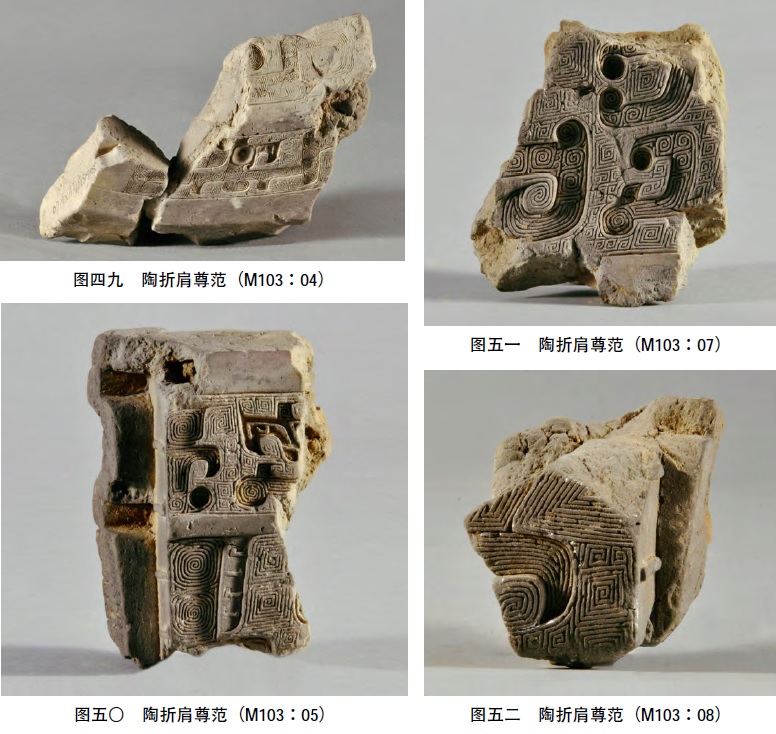 |
Four pieces of a mould for casting of a bronze vessel. The elements of the deep relief, with spirals as background decoration, can clearly be seen. From Zhongguo Shehui Kexue Yuan Kaogu Yanjiusuo Anyang Gongzuodui (2016). |
Inscriptions like texts or insignia were either incised into the mould, resulting in elevated words (yangwen 陽文), or carved into a separate model, resulting in elevated word on a separate mould piece which was then attached on the final mould, resulting in an engraved inscription (yinwen 陰文). The process was not so complicated because texts on bronze vessels were very brief during the Shang period.
The separate handles of some types of vessels (you 卣 or hu 壺) were produced with the help of cords serving as models.
When the mould was finished, the model inside was burnt in a method called "burn-and-loss technique" (fenshifa 焚失法) (Zhou 2000: 403).
In all important sites of the Shang period, kilns were found to mix and melt the metals. They were fired by charcoal (mutan 木炭). The molten metals were cast (jiaozhu 澆注) into the pouring gate or sprue (jiaokou 澆口) of the mould (mostly one of the legs), while the air went out through a second hole, called vent (maokou 冒口). Smaller objects could be cast in one go (hunzhu 渾鑄).
Casting in several parts (fenzhu 分鑄) could be done by first casting the body of the vessel, and then the legs or handles (houzhufa 後鑄法), or vice versa (xianzhufa 先鑄法). One procedure is the use of mortise and tenon (sunmao shi 榫卯式), only feasible with thick-walled objects, another one the use of rivet-like objects (liujie shi 鉚接式), and a simpler method add-on casting (zhujie shi 鑄接式). Tenon and rivet are made of bronze and the linkage was therefore nearly invisible.
There were some objects with specialized manufacture, namely yue-type axes with iron blades, dagger-axes or spearheads with jade blade and bronze handle, or objects decorated with cast-on turquois stones.
Polishing with the help of grinders (moshi 磨石) was part of the process of producing bronze objects.
The oldest artifacts of pottery, found in Xianrendong 仙人洞 near Wannian 萬年, Jiangxi, and Zengpiyan 甑皮岩, Guilin 桂林, Guangxi, are 6-7,000-years old, and in northern China, the artifacts from Peiligang 裴李崗, Xinzheng 新鄭, Henan, and Cishan 磁山 close to Wu'an 武安, Hebei, are 5-6,000-years old.
Early Shang pottery inherited the traditions of the Yangshao 仰韶 (5000-3000 BCE) and Longshan 龍山 (3200–1850 BCE) cultures, but underwent changes in shapes, types, and styles until the end of the Anyang period (1250–1050 BCE). In daily life, earthenware was used for storing, cooking, and serving meals and liquids. The early ding 鼎-style tripods used for cooking were largely replaced by li 鬲-style tripods with pointed legs. Openings became wider, and new types appeared, such as the two-storey yan 甗 for steaming, or simple weng 瓮 and gang 缸 pots for storing. Dinnerware saw the invention of a high-foot dou vessel (zudou 足豆) and the emergence of the gui 簋.
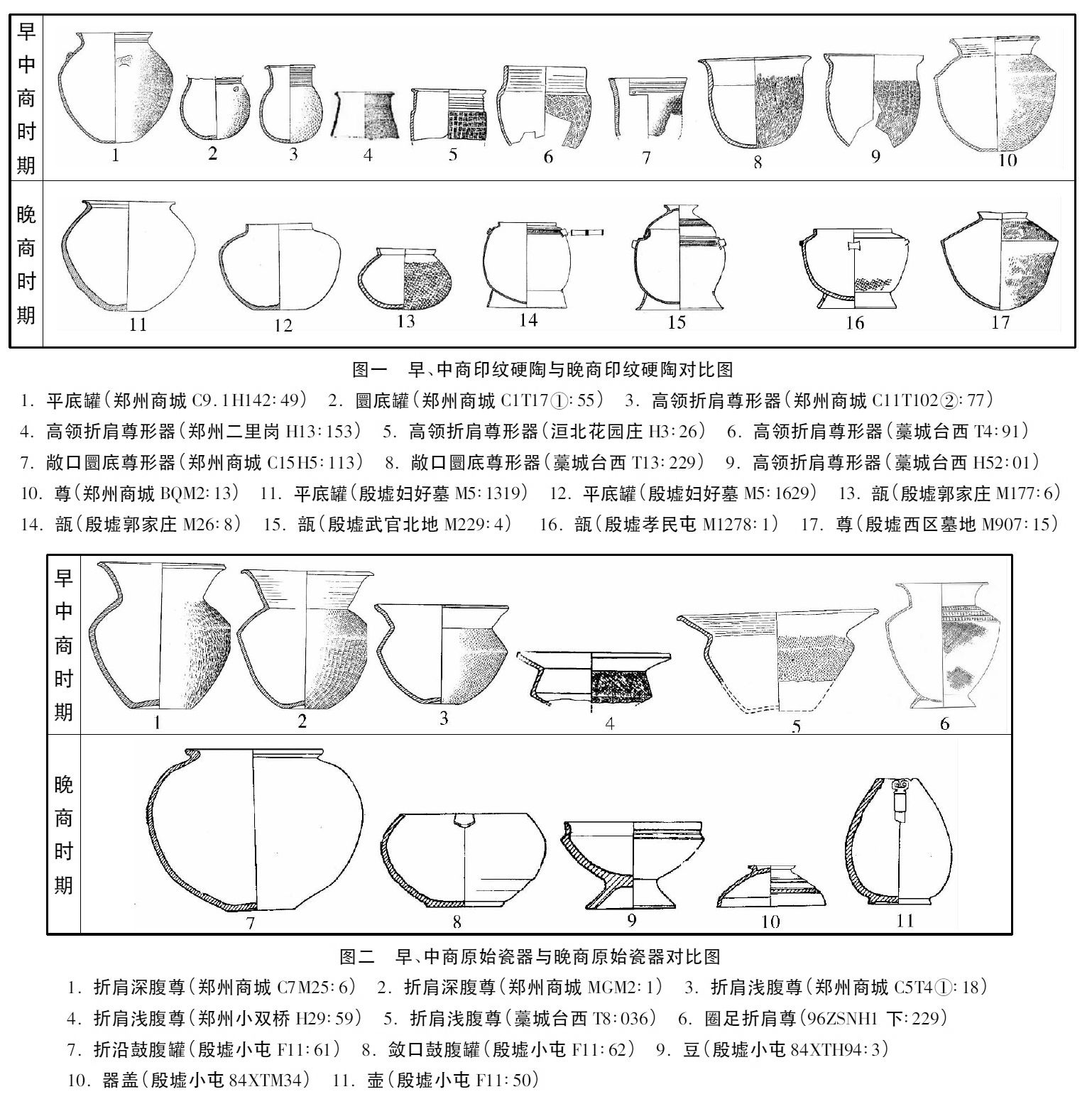 |
Examples of Shang-period pottery, mostly guan 罐, zun 尊, and pou 瓿 vessels, one short-footed dou 豆 (lowest row, no. 9), and one hu 壺 (lowest row, no. 11), with differences shown between early (upper rows) and late (lower rows) Shang types. Source: Li 2014: 60-61. |
Other items made of ceramics were spindle whorls (fanglun 紡輪, Kuhn 1988: 142-147), weights for fishing nets (wangduo 網墮), knives, and decoration markers or "pottery pestles" (taopai 陶拍) used for ornamenting the surface of earthenware vessels (Cheng 1960: 94). Ceramic tubes for drainage were found in several Shang sites. Those in the building complex of Miaopu 苗圃, Anyang, were 33cm-long and had a diameter of 15-17cm. In Baijiafen 白家墳, Anyang, many metres of drainage canals were found (Zhou 2000: 409). Some of the tubes were marked with a number, showing that the tubes were produced by regular manufacture.
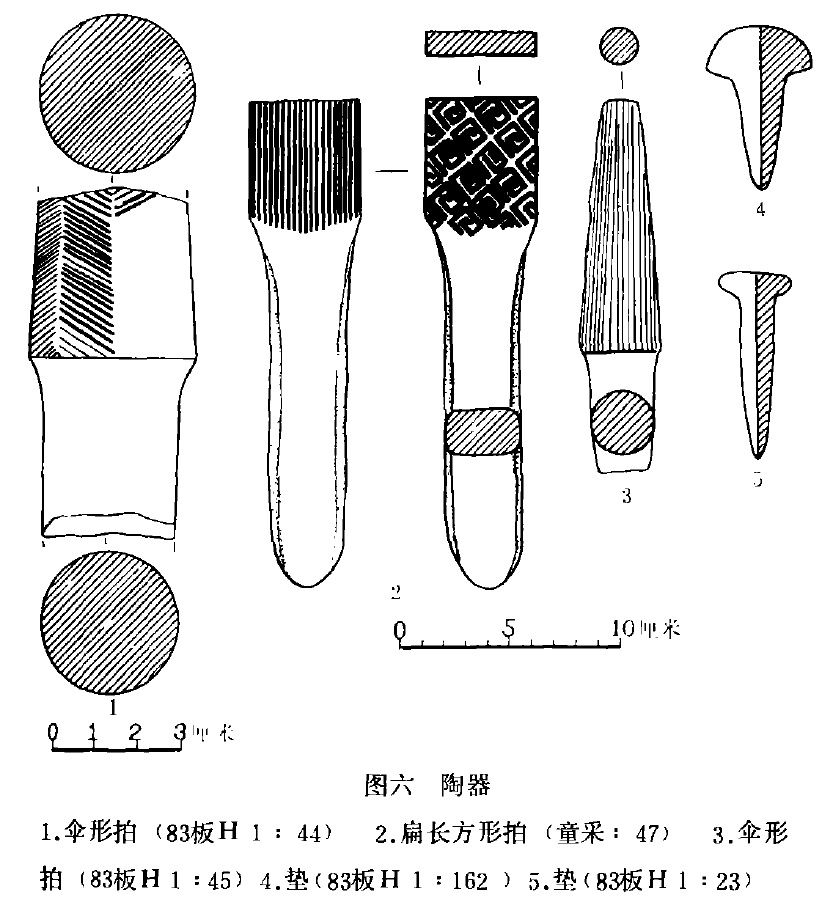 |
Decoration markers or "pottery pestles" (taopai 陶拍) with different patterns (stripes, spirals) from Yingtan 鷹潭, Jiangxi. Some have the shape of flat brushes, others are round and "umbrella-shaped" (sanxing 傘形), yet others look like mushrooms (dian 墊). Source: Li 1990: 37 |
Erligang was the first site in which earthenware figurines were discovered, like tortoises, tigers, sheep heads, fishes, pigs, or birds. In the same place, earthernware ocarinas (taoxun 陶塤) were found.
There were four types of earthenware, namely such made of clay (nizhi 泥質), sand (shazhi 砂質), clay mixed with sand or other minerals (jiazhi 夾質), and kaolinite (citu 瓷土, gaolingtu 高嶺土). The type of clay mixed with sand (chanheliao 羼和料) made out about one third of all objects, but mainly for cooking vessels (Zhou 2000: 410). The mixture lowered the tendency of clay to contract during the drying or firing process, and raised the ability of the material to absorb shocks or the heat of cooking.
The loess soil (huangtu 黃土) found all over the Yellow River plain has a high content of Calcium oxide (CaO) which is not easy to wash out (taoxi 淘洗) and therefore makes shaping of earthenware vessels or even that of bricks not easy. Chinese craftsmen therefore used clay (nitu 泥土), laterite (hongtu 紅土), chernozem (heitu 黑土), or sedimentary soil (chenjitu 沉積土) (Zhou 2000: 411; Kerr, Wood 2004: 103). In Chinese kaolinite, the content of aluminum oxide is very high in contrast to ferrous (iron) oxides which makes the colour of proto-porcelain much white (baitao 白陶). From the early Shang period on, proto-porcelain became popular, and was widely used in most Shang-period sites. In the Anyang period, richly decorated whiteware was a precious item. Shards (taopi 陶坯) made of ferrous material became red after firing in oxidizing, and gray or black in non-oxidizing environment. The higher the content of iron oxides, the lower the firing temperature.
Stamped hard pottery (yiwen yingtao 印紋硬陶) was widely used as early as the Erligang phase. Its firing temperature was 1200°, resulting in hard, shock-resistant, and waterproof ceramic. The patterns impressed on the surface of the soft shard were geometrical and reached from simple dots or grids to spirals and clouds. The custom of decorating jars by imprints originated in the Yangtze River valley and gradually spread to the north in the course of the Shang period.
Proto-porcelain (yuanshi ciqi 原始瓷器), also called glazed ware (youtao 釉陶, Kerr, Wood 2004: 456), was found in Erligang and many other Shang-period sites, but was more widespread in the south than in the Yellow River Plain. The quality of the shard was considerable, with a hard, sounding, and resistant material. The glaze was grey-green, dark yellow, or brown. The firing temperature of proto-porcelain was about the same as that of stamped hard pottery, and thus more or less corresponded to that of genuine porcelain. The same is true for the constitution of the material, with a quota of 74-76 per cent of silica (SiO2), 17-18 per cent of aluminum oxide (Al2O3), and of 2-4 per cent of iron oxide (Fe2O3) (Zhou 2000: 413-414).
Quite interesting is that even if the technique of stamped hard pottery and proto-porcelain originated in the Yangtze region, the designs and shapes were dominated by the "metropolitan" tradition of Erligang and Anyang.
The manufacture of ceramics included the potter's wheel, models, and handwork for details or for building up the body of larger vessels by piling up coils of clay (nitiao panzhu 泥條盤築). The existence of models (mo 模) is being hotly debated. One argument for the use of models is that the widespread li-type tripods, whose inner "bag"-legs (daizu 袋足) are part of the holding space, cannot be made by using a potter's wheel.
 |
Comparison between li-type vessels from the Erlitou period (1st and 2nd from left) with such from the Anyang period (two vessels to the right). Iijima 2011, plate 6/1-2; Anyang Shi Wenwu Kaogu Yanjiusuo 2002, fig. 6, 21. |
Kilns (yao 窯) were found in many Shang-period sites. There were four types of kilns. The small rising-blaze kilns (shengyanyao 升焰窯), also called vertical kiln (shuxueyao 竪穴窯) were fired from a fire chamber (huotang 火膛) below, where the blaze rose through a kiln grid (yaopai 窯箄) into the firing chamber (yaoshi 窯室). The large "dragon kiln" (longyao 龍窯; Kerr, Wood 2004: 302, 348) or even-blaze kilns (pingyanyao 平焰窯) was only used in Wucheng 吳城, Jiangxi. The firing chamber had a rising floor, and the fire was created at the mouth of the kiln. These two features allowed to grade temperatures and to fire ceramics of different properties. A kiln found in Feijiahe 費家河 near Yueyang 岳陽, Hunan, had a special construction with pits (80cm) dug into the earth. The fuel consisted perhaps of a layer covering the bottom of the pits upon which the earthenware was placed, surrounded by further combustibles as wood, rice straw or chaff. The firing temperature cannot have exceeded 700° (Zhou 2000: 419). A fourth firing method was the use of a small vertical kiln in which the earthenware was placed besides the fire, but somewhat elevated.
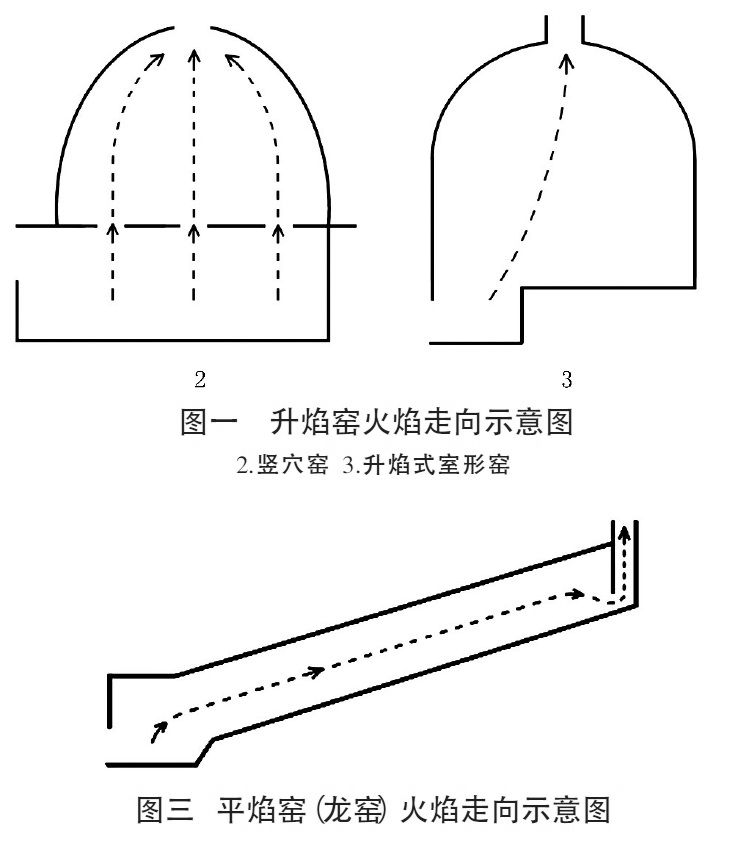 |
 |
Left: Vertical kiln with grid and kiln with a firing chamber rising towards the rear part and the vent. Li and Sun 2017: 62 Right: Kilns found in Feijiahe 費家河, Hunan, the upper one showing simple kiln pits, the lower drawing showing a smaller vertical kiln type without a grid. The shards are placed in a niche located somewhat higher than the fire. He (1985): 3. |
|
In most cases, kilns were grouped. The excavations in Yanshi brought to light so far 8, those in Erligang 14 kilns. Nearby, workshops were discovered with remains of raw material, stamps for decoration, tools, and waste of broken shards. Workshops apparently divided certain tasks among them. The remains showed that specific types of pottery was only found in one place, while wastes of others were seen in different places, for instance, workshops for the production of large storage vessels were different from those producing jue or jia drinking vessels or li and ding tripods. Sites like Wucheng included different types of kilns (total number 63) which leads to the conclusion that specific types of kilns were used for particular purposes.
In some places, like the workshop in Jiaoshan 角山 close to Yingtan 鷹潭, Jiangxi, unearthed in 1983, pottery was richly decorated with imprints. In others, markers, numbers, or insignia are seen (Zhongguo Shekui Kexue Yuan Kaogu Yanjiusuo Anyang Gongzuodui 2006: 373; Ji 1974).
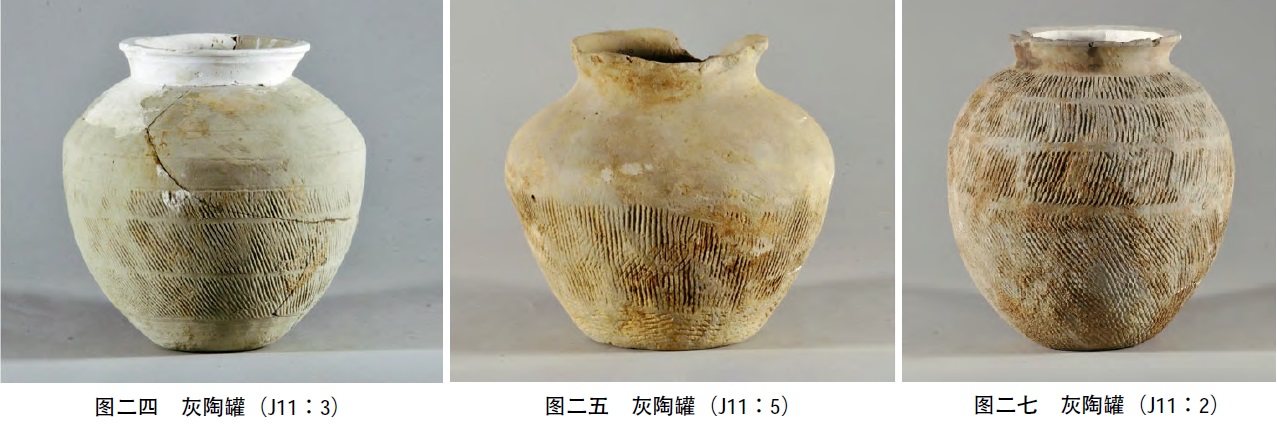 |
Jars (guan) from Anyang, decorated with simple graphical designs. Zhongguo Shehui Kexue Yuan Kaogu Yanjiusuo Anyang Gongzuodui (2016). |
Oracle bone inscriptions include quite a few characters with the radicals "cloth" (yi 衣), "net" (wang 网), "thread” (mi 糸, xi 系), "web" (si 絲), "flag" (yan 㫃) or "to bind" (shu 束). The word "mulberry tree" (sang 桑) is mentioned oftenly, yet the usual word for "silkworm" (can 蠶) is not found. "Silkworm" is rather expressed with the simple character 虫. Some scholars believe that markers close to the character signify different types of silkworms (Zhou 2000: 431).
The appearance of contemporary clothes can be seen in figurines of jade like discovered in the tomb of Queen Fu Hao. Clothes were made of hemp (ma 麻, dama 大麻, Cannabis sativa), wool, or silk. Fragments of hemp cloth were found in a dwelling in Gaochengtai 藁城臺, Hebei. The weave density was 14-16 or even 20 threads (warp) and 9-10 threads (woof) per cm (Zhou 2000: 424). Other fragments were found in tombs in Dasikongcun 大司空村 and Hougang 後崗, Anyang, as well as in that of Fu Hao. In most cases, hemp cloth (and silk) was used to wrap the precious bronze vessels used as tomb furnishings. Even if nothing remains of the material, the imprints or shadows of the cloth are visible.
The earliest prove for the use of hemp as a cultivated plant were seeds found in a pot in Dongxiang 東鄉, Gansu, of the Majiayao Culture 馬家窯 (3300-2100 BCE). They are as old as 5,000 years. In China, hemp can grow as large as 2.5-3m. The plants are dioecious, the males being called xi 枲, the female ones ju 苴 (Zhou 2000: 426).
Traces of wool were found in Gaochengtai, but woolen cloth is mentioned in early Zhou-period sources like Yizhoushu 逸周書 (ch. Wanghui 王會解, as piji 紕罽) or Shijing 詩經 (Binfeng 豳風, ode Qiyue 七月, as he 褐).
Cotton is usually believed to have been cultivated in a large style from the Song period 宋 (960-1279) on. In 1978, a late Shang-period tomb unearthed in Baiyanyadong 白岩崖洞, Wuyishan 武夷山, Fujian, fragments of cotton cloth were found (along with hemp, ramie [zhuma 苧麻], and silk). Some oracle bones found in Anyang in 1936 are also believed to have been wrapped into cotton cloth.
A tomb in Dasikongcun, Anyang, included a jade figurine of 3.1cm of what is believed to be a silkworm (Ma, Zhou, Zhang 1955: 54-55, plate 17).
There are some characters in oracle bone inscriptions variously interpreted as "unreeling silk threads from cocoons" (saosi 繅絲). The spinning (fang 紡) of threads or fibres (xianwei 纖維) can be attested by finds of spindle whorls (fanglun 紡輪) made of clay or stone (Kuhn 1988: 142-147). Threads were twisted (jianian 加拈) before reeling and weaving (Zhou 2000: 433). Finds of woven (zhi 織) textiles show a relation of warp to weft of 8 : 7 in the case of plain weaving (pingwenzhi 平紋織) (Zhou 2000: 432). Rib or crepe weaving (qiwenzhi 畦紋織) required a double amount of warp threads (jingxian 經線) in relation to weft threads (weixian 緯線). Patterned weaving (wenqizhi 文綺織) required twill weave (xiewen zuzhi 斜紋組織) in which the weft passes under three and then over one warp thread.
A closer analysis of the fabrics discovered in the tomb of Fu Hao leads to the conclusions that Shang-period silk weavers were able to produce plain silk made of untwisted thread (pingwenjuan 平紋絹) with a density of 72×26 per cm, red-dyed gauze (gao 縞, wan 紈) with a density of 60×20, fine silk with twisted threads (jian 縑, zeng 繒) woven in a warp-weft relation of 1 : 2, or 2 : 1, and gauze (luo 羅) with a density of 32×12 per cm and threads with 1,500-2,000 twists per m (Zhou 2000: 434).
The most important finds of woodwork are the 20 chariots found in Anyang (20 pieces), Laoniupo (1), and Subutun (1). Even if the wood is not preserved, the shadows seen in the soft loess soil allow to reconstruct the shape of the axis, the drawbar and draught-pole, the wheels with spokes and hub, and the chest where charioteer and archers were seated. The Shang possessed quite a few chariots, as can be seen in inscriptions which indicate a size of chariot regiments of no less than 300 vehicles. War chariots seem to have been manned with 3 persons, but the bodies of chariots found in tombs are too small to transport three men.
The chariot was introduced to China at about 1200 BCE. Initially it served as a vehicle of status and in hunting, while its military role was almost certainly limited to being a mobile and elevated command platform. Shaughnessy (1988: 228-229) believes that the chariot may have played a decisive role in the Zhou conquest of Shang.
The construction of a chariot required experts, as can be seen in the Zhou-period text Kaogongji. Chariots, at least those found in tombs, were richly decorated with bronze fittings in various positions. The body of the chariot might have been lacquered.
Jade, stone, bone, ivory, horn, and shell (bang 蚌) were popular materials and are found in most tombs of the higher classes. The craftsmen of the "lithic industry" created from these materials ritual objects (particularly jades), adornments, weapons, and objects for daily use (Ma 1994: 162-166; Bray 1984: 201). Jades might have been used as a means of storing value, similar to cowry shells, and both objects were therefore used together in the word bao 寶 "treasure". A chapter in the book Yizhoushu (ch. Shifu 世俘解) explains that King Wu 周武王 of the Zhou dynasty got nearly 200,000 pieces of jades from the possessions of the last king and the nobility of the Shang (Zhou 2000: 447). Craftsmen cut, drilled, carved, and polished to obtain the wonderful results of Shang art. Craftsmen made use of rotary discs or tubes for hard stone cutting, sawing, grinding, incising, and polishing (Cheng 1960: 118-125).
Of lacquered objects, only a few fragments and traces of carved and lacquered wooden objects have survived.
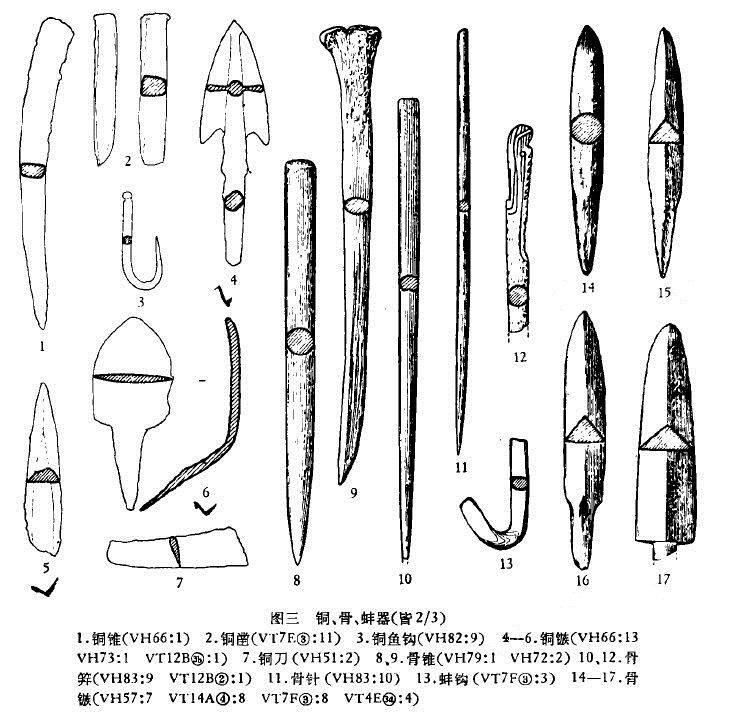 |
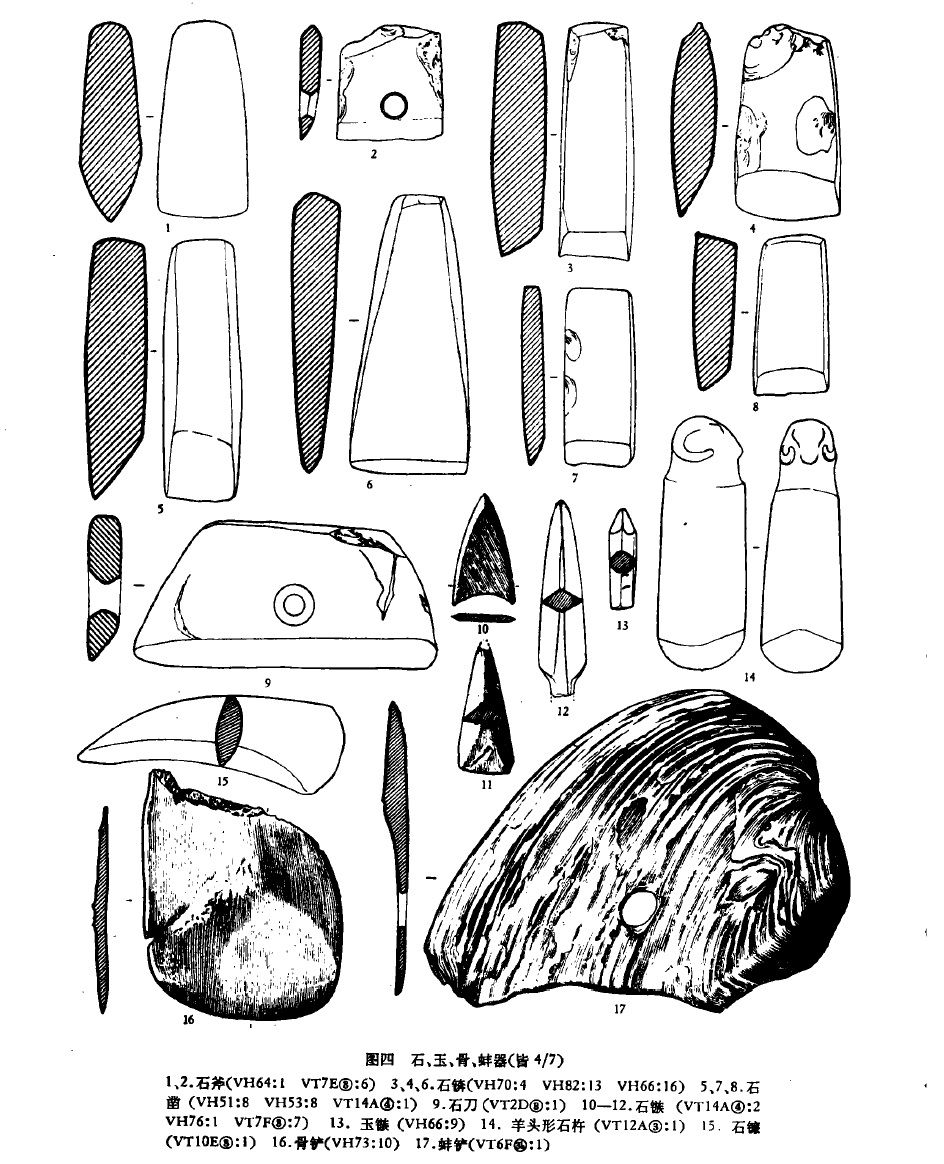 |
Awls and drills (zhui 錐), chisels (zao 鑿), fishing hooks (yugou 魚鈎), arrowheads (chuo 鏃), knives (dao 刀), hairpins (ji 笄), needles (zhen 針), axes (fu 斧), adzes (ben 錛), pestles (chu 杵), scoops (chan 鏟). From Zhonggo Shekui Kexue Yuan Kaogu Yanjiuguo Elitou Gongzuodui (1974). |
Most, but not all, Shang-period cities were protected by a wall and a moat. This is also true for outposts like Panlongcheng, Hubei, Yuanqu, Shanxi, or non-Shang sites like Sanxingdui. The most important exception in the city of Anyang. The Shang kings resided in a palace-temple complex which included various types of buildings. The large, 10m-deep tombs of the Shang kings must also be counted among construction projects. In some cases, the remains of shrines were discovered just above the place where the tomb chamber was located. In some cases, roads and canals were found inside the urban areas. The common populace lived in simple dwellings, some of them semi-subterranean.
The palace complex of Anyang was surrounded by a moat of 1,650m length, a width of 20m, and a depth of 10m. The outer wall of Yanshi was 5,330m-long and 16-25m wide at the base. The inner wall of Yanshi covered an area of 1,100×740m. The outer wall of Erligang was 6,960m-long, with a width at the base of about 20m. The palatial area of this site was also surrounded by wall and moat. The wall of the outpost of Panlongcheng covered an area of 250×290m, that of Yuanqu 350×390 (Zhou 2000: 440-442).
Palaces, temples and houses were made of timber and covered by thatched roofs, but the walls were wattle-and-daub constructions. In the case of Anyang, the palace-temple complex can be divided into three areas covering 1,767m2. In Erligang, the buildings were arranged in parallel rows facing each other (Zhou 2000: 439). Other high-class buildings were constructed like the famous traditional courtyards surrounded by three wings (siheyuan 四合院). Important buildings were erected on terraces (tai 臺) of pounded earth (hangtu 夯土) with a height of between 20 and 100cm (Zhou 2000: 440).
Based on a statement of the Duke of Zhou 周公 quoted in the chapter Jiugao of the Classic Shangshu 尚書, it is commonly believed that the word shang 商 "commerce, trade" is derived from the name of the Shang dynasty. The Zhou, victors over the Shang, ordered their people to leave the capital and to make their living elsewhere (Zhou 2000: 453). Early character dictionaries like Shuowen jiezi 說文解字 confirm this assumption that the word shang meant "to understand close [matters] by knowing that afar" (cong wai zhi nei 從外知内).
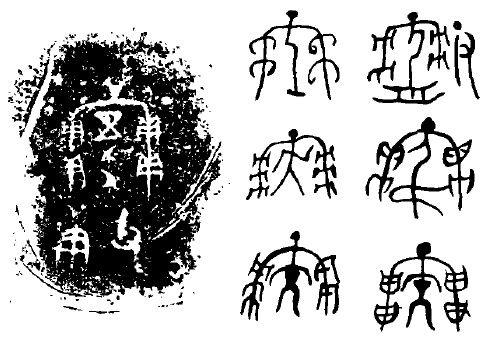 |
The character shang 商 /ɕĭaŋ/ as marker in various bronze vessels, from Zhu (1985), 5. According to the dictionary Shuowen jiezi, the character is a composition of the radical 㕯 (which is used rather graphically and includes the word ru 入 "to bring in") and the abbreviated phonetic /tɕĭaŋ/ 章. Yet the word 章 "stanza" also means "to regulate", "to measure", and thus also bears a meaning in the character 商. The bronze insignia show the image of a man bearing objects with him which are tied to a pole carried over the shoulder. |
The earliest example for trade in the Shang period is the story of Wang Hai 王亥, a pre-dynastic ancestor of the Shang quoted in the pseudo-geography Shanhaijing who traded with cows and sheep.
The amount of objects found in the remains of workshops of tombs suggest that objects like hairpins of bone (gu ji 骨笄) for females and males were not just made for personal need. The tomb of Queen Fu Hao 婦好 contained nearly 500 hairpins and nearly 7,000 cowry shells (Zhou 2000: 455, 464). It might be that the Queen hoarded these objects to present them eventually to subordinates, but also to trade them.
The amount of pottery produced in the urban kilns can only be assessed very crudely, but it is for sure that the 14 kilns of Erligang, the 8 kilns found in Yanshi, or the 63 kilns found in Feijiahe 費家河 close to Yueyang 岳陽, Hunan, yielded substantial amounts of commodities (Zhou 2000: 456).
The grade of urbanization might be a hint to the level to which commerce and other business activities had grown. The city of Yanshi was protected by three walls (palace, inner, outer), had seven gates, and covered an area of 190ha. The city of Erligang was 317ha large, and the ruins close to Anyang are spread over an area of no less than 30km2. Even outposts like Panlongcheng (7.54ha), Hubei or Yuanqu 垣曲 (12.5ha), Shanxi, Lijiaya 李家崖 (6.7ha) close to Qingjian 青澗, Shaanxi, Sanxingdui (224-294ha), Sichuan, or Dongxiafeng 東下馮 (19.36ha) close to Xiaxian 夏縣, Shanxi, were considerably large (Zhou 2000: 469-470).
The city of Erligang might have been the living place of 100,000 persons, late Anyang that of 230,000, with 5 persons per household (Zhou 2000: 471). The number of household in one settlement can be assessed on the base of statements over the number of troops a settlement was able to deliver.
Biographies of the most important advisor of King Wen 周文王 of the Zhou dynasty, Lü Wang 呂望, hold that he was once a butcher in the Shang capital Chaoge 朝歌 (also called Mei 沬 or 妹) and a trader at the ford of Mengjin 孟津, an important passage across the Yellow River.
The word "road" or "to travel" (xing 行, a symbol for a junction), and a hundred characters derived from this word, often occur in oracle bone inscriptions. Traces of roads were found in Shang-period sites. The streets of Anyang had tracks with a width of 2.15-2.4m (Zhou 2000: 473-474). Roads outside the cities must have existed in east-west direction to Feng 灃 (close to Xi'an 西安, Shaanxi) in the Wei River 渭水 valley and Subutun close to the Shandong Peninsula in the east, and in north-south direction to Panlongcheng and Linfang 林方 (Fengyang 鳳陽, Anhui) and places in northern Hebei (Zhou 2000: 477).
Carts were drawn by horses, oxen, or by two persons (nian 輦). Some scholars believe that inscriptions give hints to the existence of relay stations on long-distance roads (Zhou 2000: 484).
Apart from roads, waterways played in important role in long-distance trade. The word for "to obtain" [by commerce] (shou 受), for instance, is composed of two hands and a boat in the middle (old appearance: 𠭧), signifying exchange on a boat. Accordingly, paddles and punts are mentioned in oracle inscriptions.
Liu and Chen (2003: 51) reconstructed land and riverine transport routes from copper mines in the Yangtze area to the north and the copper deposits and salt lakes in Shaanxi and Shanxi to the east.
Even if written sources to not reveal much about commerce, it is for sure that the usual present of cowry shells (bei 貝) by the king to subordinates was used to buy metal and have cast a bronze vessel in honour of an ancestor. Cowry shells were from the late Shang period on used as a kind of currency (Zhou 2000: 459). Cowry shells were found not just in the tombs of higher dignities, but also in smaller tombs in Anyang. In one smaller tomb, 385 cowry shells were discovered (Zhou 2000: 459). A tomb discovered in Erligang included 460 natural cowry shells (Zhou 2000: 467). They belonged to the species Monetaria moneta, Monetaria annulus, Erronea errones, Mauritia arabica, Cypraea tigris, Erosaria miliaris, and some others (Zhu 1985: 5-6).
Cowry shells were counted in units of peng 朋 (a picture of stringed-up cowries?), of which Wang Guowei 王國維 (1877-1927) believes it corresponded to ten pieces (Zhou 2000: 462). Statements about the value of one peng cannot be made, at least not concerning the Shang period. Western Zhou period 西周 (11th cent.-770 BCE) inscriptions on bronze vessels make concrete statements about the cost of one bronze vessel in cowry shells or in land (Zhou 2000: 464). The Shang-period character for "to buy, to purchase", is a net with a cowry shell (𧵽), corresponding to the modern character 買. The origin of cowry shells from the Indian Ocean or the South China Sea shows how widespread trade networks were in the late 2nd millennium BCE.
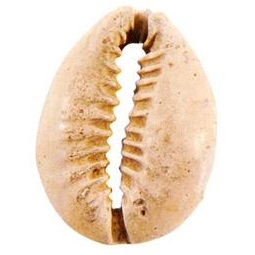 |
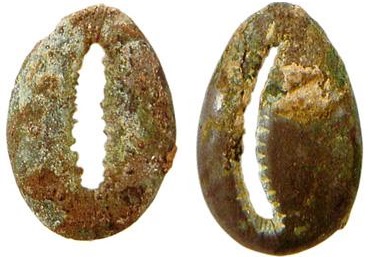 |
Left: Genuine cowry shell, length 2.5cm, width 1.7cm. Right: Bronze cowries, length 2.6cm, width 1.9cm, all from the Shang period. Owned by Beijing Ancient Coins Museum (Beijing Shi Gu Qianbi Zhanlanguan 北京市古代錢幣展覽館).
Beijing wenwu jianshang bianweihui (2005). |
|
Shang tombs do not only include genuine cowry shells, but also imitations made of bone, stone, or bronze (tongbei 銅貝). They had a size of 1.2-1.5mm. The largest amount of artificial cowries discovered so far was unearthed in a tomb in Baode 保德, Shanxi, with 109 bronze cowries, and 112 genuine ones. Scholars believe that these bronze cowries were used as decorations for a chariot (known tongpao 銅泡 "bronze blister" nailed on wooden parts), and not as coins. Three bronze cowries unearthed in Dasikongcun 大司空村, Anyang, represent "genuine currency" (Zhou 2000: 466).
Hoarding of values was usual, in the shape of bronze vessels or cowry shells, be it in hoards for the living, or as tomb furnishing. Even if some scholars wonder whether jade might likewise have been a kind of currency, there is no prove of any standardization of jade objects (Zhu 1985: 9). At least, jade was a highly "valued" (bao 寶) object and was traded from distant regions like Khotan, Xinjiang.
Oracle bone inscriptions many quite a few place names which belonged to the royal domain and whose fields were cultivated, irrigated or expanded. The harvest of these fields was used to feed the royal household. Animals on the royal pasture were consumed or used for sacrifice. The royal household's need of crafted articles was produced in state-owned workshops, the remains of which were found in most Shang-period sites.
Mengzi's 孟子 (385-304 or 372-289 BCE) statement (ch. Teng Wengong 滕文公 A) that the Shang kings required one seventh of the harvest as tax (Yin ren qishi er zhu 殷人七十而助), literally "support" (zhu 助), cannot be substantiated from contemporary sources. What Mengzi meant was perhaps the tributes to be delivered by regional lords. The book Yizhoushu (ch. Wanghui, annex Yi Yin chaoxian 伊尹朝獻 "The court tributes of Yi Yin") explains that counsellor Yi Yin 伊尹 fixed the types of tributes to be delivered from each cardinal direction, similar to Yu the Great 大禹, mythological founder of the Xia dynasty 夏 (21th-17th cent. BCE), who did the same for every province (see Yugong 禹貢).
This "edict for the regions" (Sifang ling 四方令) determined, for instance, the tributes of the regions of the east (Fulou 符婁, Chouzhou 仇州, Yilü 伊慮, Oushen 漚深,the Nine Yi Tribes 九夷, the Ten Man Tribes 十蠻,Yue'ou 越漚,and the tribes with long hair and tattoos, jianfa wenshen 鬋髮文身) to deliver drums (robes? sheathes?) made of fish skin (yupi zhi pi/bi/bing 魚皮之鞞), cuttlefish sauce (wuzei zhi jiang 𩶭鰂之醬), shields decorated with shark [skin] (jiao fa 鮫瞂),and sharp swords (li jian 利劍).
Two hymns in the Classic Shijing (Yin wu 殷武, Xuanniao 玄鳥) report of court audiences during which tributes were delivered. Typical words for the delivery of tributes during court audiences were lai 來, gong 供, zhi 氐 (=zhi 致), xian 見 (=現,獻), ru 入 (=na 納), or deng 登, and seen from the perspective of the ruler qu 取, mei 眉, gai 匄, or qi 乞 (Zhou 2000: 489).
The hymns say that the Di 氐 and Qiang delivered tributes to the Shang court, and that the regional rulers presented part of their harvest to the Shang. This happened at the foundation of the dynasty, as stated in the book Xunzi 荀子 (ch. Jiebi 解蔽) and Huangfu Mi's 皇甫謐 (215-282) Diwang shiji 帝王世紀.
Oracle bone inscriptions list quite a few items, along with numbers, presented to the Shang court, such as 20, 50, 300, 506, or even 900 slaves (ren 人, herdsmen chu 芻, hunters qiang 羌), freshly harvested millet (compare the character 來, which is actually the picture of a millet plant), 400 cattle, 300 sheep, 30 horses, game or other wild animals (monkeys, rhinos), sounding stones (shi 石, actually qing 磬), a boat, pieces of (worked) jade, ivory, salt (lu 鹵), cowry shells or tortoise shells, or manufactured products as bronze vessels, weapons, textiles, or whole settlements (yi 邑) including their population (Wang and Yang 1996: 277-279, Zhou 2000: 490-495).
Among persons presented to the Shang kings were also such of higher ranking for court services, like chen 臣, pu 僕, wu 巫 "shamans", tun 屯 ?, nü 女, or qie 妾 (Zhou 2000: 491). Qiang 羌 was a general term for captives, not necessarily from the western tribe of the Qiang. Often enough, these were used as human sacrifices.
There was thus an upward and centripetal flow of economic resources from the allied or subordinated regions to the political centre in the shape of grain, domestic animals, industrial products, services, tortoise carapaxes, cowry shells, bronze, jades, which "came in" (ru 入), but sometimes the king toured the country to "pick them up" (qu 取, Chang 1980: 236).
The Shang court afforded extremely high expenditure for the many sacrifices to the various ancestors. Considerable numbers of sacrificial animals and human sacrifice were due for the rituals regularly carried out through the year. In addition to that, the death of a ruler required substantial effort for the construction of the tomb and to furnish the burial chamber of the late king. Banquets (as a ritual to cement social relations) and presents (yi 易=ci 賜) to subordinates and local lords added to the bill, as well as lavish robes for the many consorts and court women, and last, but not least, the need to equip the royal army and that of the regional rulers for the many wars.